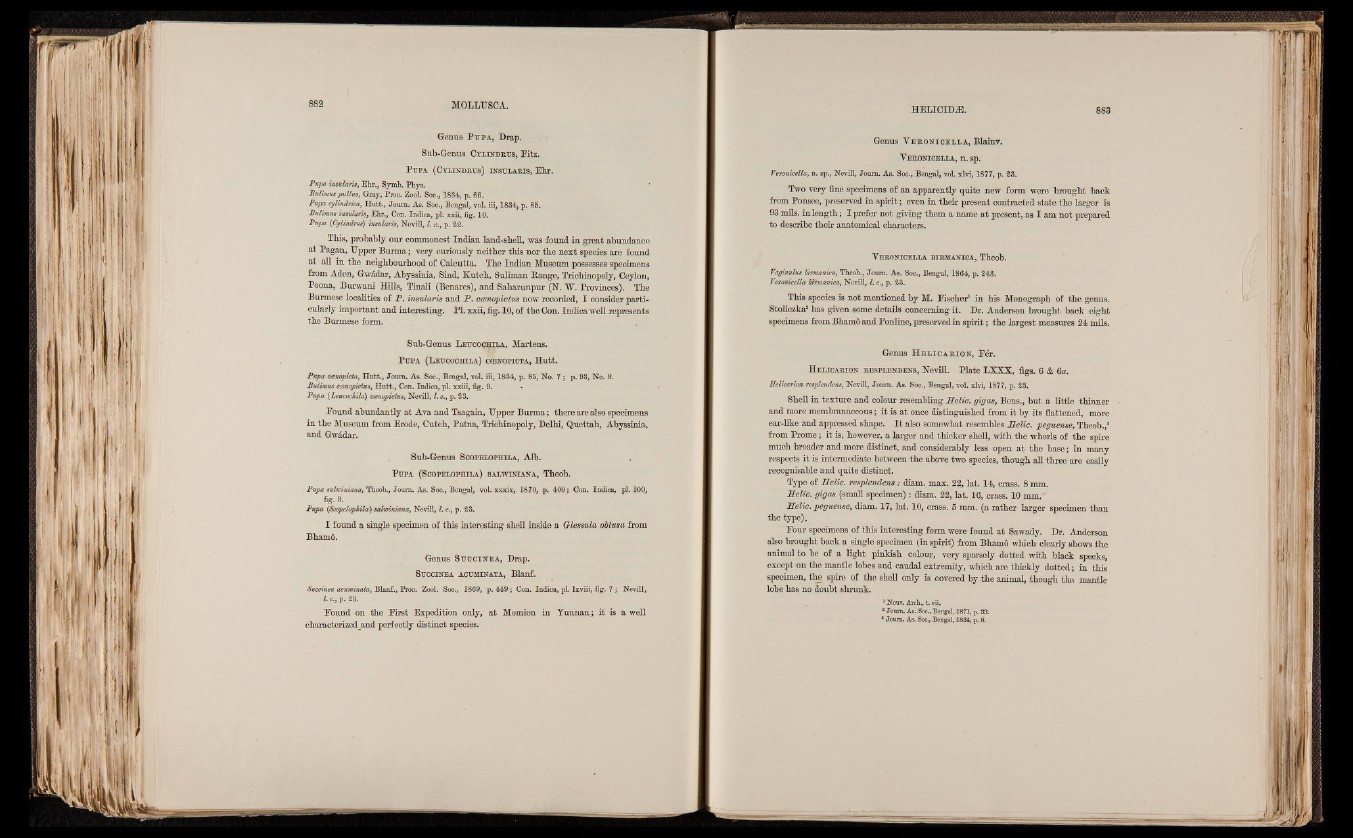
Genus P t j p a , Drap.
Sub-Genus C y l in d r u s , Pitz.
P u p a (C y l i n d r u s ) i n s u l a r i s , Ehr.
Pupa insularis, Ehr., Symb. Phys.
Bulimus pullus, Gray, Proc. Zool. Soc., 1884, p. 66.
Pupa cylindrica, Hutt., Joum. As. Soc., Bengal, vol. iii, 1884, p. 85.
Bulimus insularis, Ehr., Con. Indica, pi. v*™, fig. 10.
Pupa (Cylindrus) insularis, Nevill, I. c., p. 22.
This, probably our commonest Indian land-shell, was found in great abundance
at Pagan, Upper Burma; very curiously neither this nor the next species are found
at all in the neighbourhood of Calcutta. The Indian Museum possesses specimens
from Aden, Gwadar, Abyssinia, Sind, Kutch, Suliman Range, Trichinopoly, Ceylon,
Poona, Burwani Hills, Tinali (Benares), and Saharunpur (N. W. Provinces). The
Burmese localities of P. insularis and P . ceencpictus now recorded, I consider particularly
important and interesting. PI. xxii, fig. 10, of the Con. Indica well represents
the Burmese form.
Sub-Genus L e u c o c h il a , Martens.
P u p a ( L e u c o c h il a ) c c e n o p ic t a , Hutt.
Pupa ctmopicta, Hutt., Joum. As. Soc., Bengal, vol. iii, 1884, p. 85, No. 7 ; p. 98, No. 9.
Bulimus canopictus, Hutt., Con. Indica* pi. xxiii, fig. 9.
Pupa (Leucochila) ceenopicius, Nevill, I. <?., p. 23.
Pound abundantly at Ava and Tsagain, Upper Burma; there are also specimens
in the Museum from Erode, Cutch, Patna, Trichinopoly, Delhi, Quettah, Abyssinia,
and Gwadar.
Sub-Genus S o o p e l o p h il a , Alb.
P u p a ( S o o p e l o p h il a ) s a l w i n i a n a , Theob.
Pupa sahoiniana, Theob., Joum. As. Soc., Bengal, vol. xxxix, 1870, p. 400; Con. Indica, pi. 100,
fig. 9.
Pupa (8copeloph.Ua) salwiniana, Nevill, I. c., p. 23.
I found a single specimen of this interesting shell inside a Glessula obtusa from
Bhamd.
Genus Sue c i u e a , Drap.
SuCCINEA ACUMINATA, Blanf.
Succmea acuminata, Blanf., Proc. Zool. Soc., 1869, p. 449; Con. Indica, pi. lxviii, fig. 7 ; Nevill,
I. c., p. 28.
Pound on the Pirst Expedition only, at Momien in Yunnan; it is a well
characterized and perfectly distinct species.
Genus Y e r o n i c e l l a , Blainv.
Y e r o n ic e l l a , n. sp.
Veronicella, n. sp., Nevill, Joum. As. Soc., Bengal, vol. xlvi, 1877, p. 23.
Two very fine specimens of an apparently quite new form were brought back
from Ponsee, preserved in spirit; even in their present contracted state the larger is
93 mils, in length; I prefer not giving them a name at present, as I am not prepared
to describe their anatomical characters.
V e r o n ic e l l a b i r m a n ic a , Theob.
Vagvnulm birmanica, Theob., Joum. As. Soc., Bengal, 1864, p. 243.
Veronicella Wmmica, Nevill, I. <?., p. 23.
This species is not mentioned by M. Pischer1 in his Monograph of the genus. W,
Stoliczka2 has given some details concerning it. Dr. Anderson brought back eight
specimens from Bham6 and Ponline, preserved in spirit; the largest measures 24 mils.
Genus H e l i c a r i o n , Pér.
H e l ic a r io n r e s p l e n d e n s , Nevill. Plate LXXX, figs. 6 & 6a.
Helicarion resplendens, Nevill, Joum. As. Soc., Bengal, vol. xlvi, 1877, p. 28.
Shell in texture and colour resembling Helic. gigas, Bens., but a little thinner
and more membranaceous; it is at once distinguished from it by its flattened, more
ear-like and appressed shape. I t also somewhat resembles Helio, pegúense, Theob.,8
from Prome; it is, however, a larger and thicker shell, with the whorls of the spire
much broader and more distinct, and considerably less open at the base; in many
respects it is intermediate between the above two species, though all three are easily
recognisable and quite distinct.
Type of Helic. resplendens: diam. max. 22, lat. 14, crass. 8 mm
Helic. gigas (small specimen) : diam. 22, lat. 16, crass. 10 nun."'
Helic. pegúense, diam. 17, lat. 10, crass. 5 mm. (a rather larger specimen than
the type).
Pour specimens of this interesting form were found at Sawady. Dr. Anderson
also brought back a single specimen (inspirit) from Bhamó which clearly shows the
animal to be of a light pinkish colour, very sparsely dotted with black specks,
except on the mantle lobes and caudal extremity, which are thickly dotted; in this
specimen, the spire of the shell only is covered by the animal, though the mantle
lobe has no doubt shrunk.
1 Nouv. Arch., t. vii.
9 Journ. As. Soc., Bengal, 1871, p. '33.
8 Joum. As. Soc., Bengal, 1834, p. 8.